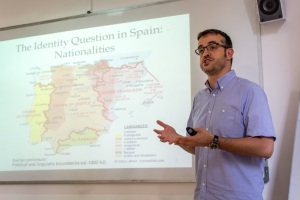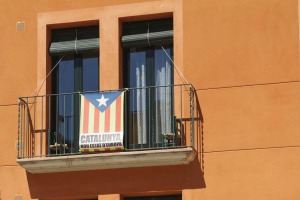Story by Morgan Lawrence
BARCELONA – With fewer than two weeks until Barcelona’s municipal elections, the issue of Catalonian independence – the longstanding push for self-government by the country’s wealthiest and culturally independent province – is aggressively at the forefront of public consciousness.
The elections will determine who will be brought into Barcelona’s City Council by popular vote. How those candidates stand on the issue of independence has the potential to impact the viability of the movement on a tangible, practical level.
So said Antoni Raja-i-Vich, a professor of history and Spanish culture at Universitat Autònoma de Barcelona (UAB).

Antoni Raja-i-Vich, a professor at Universitat Autònoma de Barcelona, lectured recently about Catalan’s bid for independence from Spain and the movement’s complicated relationship with the national media. Photo by Joe Thomas
As with any election, Raja-i-Vich said in a lecture this week at a language school in Barcelona, popular opinion and its relationship to mass media are particularly important. The key to understanding the current state of the independence movement, therefore, is to unravel the complicated nature of Spain’s media companies and coverage. To do so requires an understanding of the convoluted inner workings of press networks, the coverage they provide and the views they espouse.
While Catalonian independence is not on the ballot yet, a recent vote put to Scottish nationals to secede from Great Britain has set a precedent and lit a fire under those in northeastern Spain who want the same to happen here.
“If you think that these Catalans and Basques are freaks, I would agree,” Raja-i-Vich joked about the two autonomous regions in the country that have sought independence from the state. “But … clearly what happens in Catalonia is not unique,” he said. “I think nobody is happy with their identity.”
As it happened in Scotland, those pushing for independence within Catalonia called for a referendum in late 2014, bringing the issue to a vote in the region’s four provinces; unlike Scotland, it was not taken on by the government at large for a popular vote across the nation, despite the 80 percent result in the referendum in favor of self-governance.
Putting that vote to citizens without the endorsement of the national government, and therefore without any true legal repercussions, was seen as both a statement and a protest, said Raja-i-Vich. In effect, it was meant to pressure the government in Madrid to call a national vote on the subject, the likelihood of which is still unclear.
That’s why the upcoming municipal elections, on May 24, are so critical: They could be a step in galvanizing support on a higher political level, should pro-independence officials be elected.
Nevertheless, Raja-i-Vich emphasized the ways in which the independence movement in Catalonia is unique – illustrated by the region’s complicated relationship with the national press here.
The first aspect is the fundamental divide between the press in Spain at large versus press in Catalonia, which is comprised of four provinces with Barcelona as the capital. The region has its own parliamentary government, its own language and its own honored culture – distinct from Spain’s.
“If you read Spanish newspapers, [and look to answer] the question … ‘How do you feel about independence?’ – the answer is always ‘No way,’” said Raja-i-Vich. But on the streets, the response is different. Residents proudly display their striped yellow and red Catalonian flags with a starred triangle from their balconies and banisters – proclaiming loudly to passersby that they want to secede.

A Catalan independence flag, known as the “Estelada” (the “Starred”), hangs from a balcony in Girona, a city in Catalonia. The flag features a blue triangle and white star, on the traditional red and yellow background. Photo by Clara Cutbill
He emphasized that the lack of supportive coverage in Spanish newspapers, over time, has become less damaging to the activist movement. He cited an example from one typically anti-independence Spanish paper, La Razon, that downplayed a massive 2014 pro-independence demonstration.
The result? It became a form of proof to Catalonians on the fence about independence that claims of oppression by the larger Spanish nation were valid.
Raja-i-Vich also noted that while Spain’s media companies might seem to be solely driven by their political agendas, they are just as guided by their desire to rake in advertising and reader revenue. To trace the origins of the large-scale media companies here is to find paths to both the conservative and liberal sides of politics. Therefore, Raja-i-Vich said, it’s not possible to view the media’s often one-sided handling of issues as authentic support.
Barcelona-based Grupo Planeta, for example, is a powerful publishing company that owns both the traditionally conservative, anti-independence Spanish television station Antena 3, as well as La Sexta, a “very left-wing, radical TV station” that largely supports the independence movement.
Finally, though, Raja-i-Vich noted that these obstacles have not prevented a mainstream voice in favor of the Catalonia cause. La Vanguardia and Ara – published out of Catalonia – are both written in the region’s Catalan language – which is distinct from Spanish. La Vanguardia was initially published in Spanish, making the switch in 2011. A radio station by the same parent company, RAC 1, provides news with a noteworthy pro-independence slant; it now has a substantial listenership. “There was no radio station offering that ideology; now [this is] the most popular radio station in Catalonia,” he said.
One website, Nacio Digital, he credits with removing the “radical” stigma from the very political Catalonian flags by hawking mainstream merchandise with the flag emblazoned as a logo. Finally, and most notably, a local Catalonian television station, 8TV, has partnered with CNN, opening up the potential for a “change” in how it sees the Spain-Catalonia conflict, with a more sympathetic eye toward the latter.
This could have wide implications, pro-independence activists hope, as it could help the world finally understand where independence seekers are coming from.
“As you can see,” Raja-i-Vich said dryly in summary, “journalists in Spain have lots of things to work on lately.”



Pingback: Phase One: Complete | M. Lawrence
Nice work!
LikeLiked by 1 person